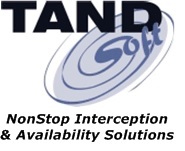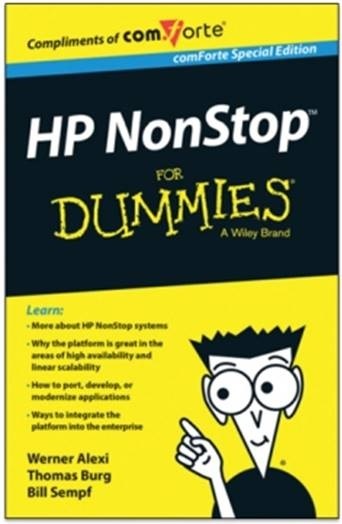
Tandemworld eNewsletter for October 2015
Gold Sponsor is
Silver Sponsor is
Tandemworld eNewsletter
for October 2015
Contents
Tape: Absolutely Relevant
Today and Tomorrow
TANDsoft Introduces the SDI Toolkit for Sensitive Data Intercept
The FedEx of file movement …
BITUG News – BIG SIG 2015
Musings on NonStop! - October, ‘15
comForte closes best financial
year in company history
Prognosis Continues to Deliver Value for NonStop X Users
comForte at the NonStop Technical
Boot Camp in San Jose, Nov 15-18, 2015
Secure Data and Accelerated Applications
comForte's Limited
Edition 'HP NonStop for Dummies' Book!
Gravic Announces New
Shadowbase Website
comForte at events near you in 2015 and 2016
NonStop Technical Boot Camp
2015
Tape Catalog
Optimizer (TCO) from QSA Enterprises makes file recovery a piece of
cake.
CSP - a New day HAs
Come for nonstop security OmniPayments is
Extending Its NonStop X Family
Performance Analysis: Why go outside?
Availability Digest
Explains How Japanese Data Centers Survived the March 2011 Earthquake
XYPRO – Security Intelligence – Intercepting “Low and Slow”
XYPRO – HP NonStop Advanced Technical Boot Camp Current Subscribers 15142
Tape: Absolutely Relevant Today and Tomorrow
By Glenn Garrahan, Director of HP Business for Tributary Systems
“The reports of my death have been greatly exaggerated” Samuel Clemens (Mark Twain)
Except for the fact that it was made over a century ago, Mark Twain’s tongue-in-check comment on the reports of his own demise could have been made today about the state of tape, and particularly LTO, in the enterprise.
Periodically we all read articles or newsletters predicting the end of tape based storage, but the facts just don’t seem to bear this out, life support just isn’t required any time soon.
Magnetic Tape- a little historical context:
Magnetic tape for audio recording was first invented by Fritz Pfeumer, a German engineer, in 1928. Pfeumer’s system used a ferric oxide coating on a long strip of paper. Improvements came quickly, with AEG manufacturing the recording hardware, and BASF developing the actual tape media. By the early 1940’s, audio recording using magnetic tape had improved to such a degree that it was kept classified by the German government. In fact tape was used to record leadership speeches, which were then broadcast simultaneously in various locales. The quality was so good that Allied military planners couldn’t determine where the original speech was given, allowing the German leadership to avoid being bombed during a speech. You might say this was the first instance of tape being used for disaster avoidance.
At the end of the Second World War, the allies discovered the German advances in audio recording with magnetic tape, and in the ensuing years companies like Ampex and Sony developed the technology for both audio and then later video recording.
The first use of tape for recoding computer data was in 1951, in conjunction with the UNIVAC 1. The media was a one-half inch wide thin metallic strip, with a recording density of 128 characters per inch on eight tracks. Ironically, the modern LTO media is also one-half inch in width, but the density is somewhat higher!
early tape drives were floor-standing reel-to-real units that used vacuum columns to physically buffer long U-shaped loops of tape. The two tape reels visibly fed tape through the columns, intermittently spinning the reels in rapid, unsynchronized bursts, resulting in visually striking action. Stock shots of such vacuum-column tape drives in motion, along with randomly blinking colored lights, were widely used to represent "the computer" in movies and television of the 1950’s thru the 1970’s.Modern cartridge style media began to gain popularity in the 1980’s, and it wasn’t long before this media type displaced the open reel-to-reel units, due to the ease of use, simplicity of archiving cartridge based media, and reduced possibility of media damage when manually reloading large reels of loose tape. Cartridges have been available in several formats, modern types include DAT DDC, DLT, and of course the most ubiquitous format of all, Linear Tape Open, or LTO.
Why tape?
Archiving- As we all are aware, data is growing at an ever accelerating rate, estimates are that 90% of all data ever created originated in the previous 12 months. IDC’s Digital Universe survey is estimating a massive 40 zettabytes (or 40 billion terabytes) of data will be created by 2020, up from only 3 zettabytes in 2012. Where to put this avalanche of data for the long haul? Tape! With its density and economies of scale, and an estimated 15-30 years of on-the-shelf lifespan, tape is and will remain an excellent backup and/or archival choice.
Dependability- LTO tape has proven more reliable than disk, especially low cost disk. The National Energy Research Scientific Computing Center (NERSC) estimates that tape cartridges are up to four orders of magnitude more reliable that SATA disk.
Sales- HP stated in their 2014 Whitepaper” The Future Direction of Tape Media” that in its first 18 months LTO 6 had surpassed its predecessor LTO 5 in terms of adoption rates. HP further stated that since the introduction of LTO in 2000, over 69 million HP MP (Metal Particle) tape cartridges have shipped to customers, and that’s just HP! Why the popularity? Cost-per-terabyte of course! A 1.5 TB Native LTO 5 tape cartridge, for example, averages about $20 each. With a very realistic 2:1 compression, you’re talking about a cost of only $6.70 per terabyte. Enterprise class HDD’s cannot come anywhere near that number.
Performance- “Disk is faster than tape”- well, it depends. Performance is affected not only by the magnetic media type, but also the speed of the disk system and the autoloader/library. Disk will generally be faster with random access reads/writes, but for sequential reads/writes, tape will more often than not outperform HDD’s, making tape the media of choice for backups, archiving, and big data.
Cloud Compatibility- Tape in the “Cloud”- why not? Many cloud data centers own massive tape libraries for long-term economic data storage. Scientific users combining cloud and tape include CERN, the Argonne National Laboratory, and NASA. In broadcasting, where absolutely massive amounts of digital film and television data require archiving, The Discovery Network is a top example. In education, USC (University of Southern California) uses tape-based storage to archive digital holdings in the cloud. Tape and “Cloud” are partners, not adversaries….
Hmmm, doesn’t seem that tape needs the resuscitator just yet……
About LTO
LTO Ultrium tape was first made available to the marketplace in 2000. Developed and controlled by a consortium of companies, Hewlett-Packard, IBM, and Quantum, LTO quickly became the dominate enterprise tape drive type, competing favorably DAT, DLT, AIT, and all other mid-range devices. Actually, both DLT and AIT are no longer in production, having been entirely displaced by LTO.
Currently LTO is in its sixth generation, with LTO 6 initially introduced in 2012. LTO 7, the next iteration, is just on the horizon, with expectation of an FCS in December 2015. Each generation of LTO has enhanced both media capacity and speed, while allowing for media compatibility with previous generations. Protection of customer investment in LTO was a major criterion of the product line, thus the compatibility requirement:
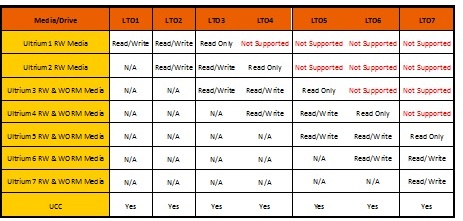
All generations of LTO, from LTO 3 onward, can read and write to the current and the previous generation of media, and can read-only back two generations.
The LTO Roadmap
The LTO consortium has released a tentative roadmap confirming that at this time 3 additional generations of LTO, beyond LTO 7, are planned, again protecting that all important customer investment in LTO tape well into the 2020’s:
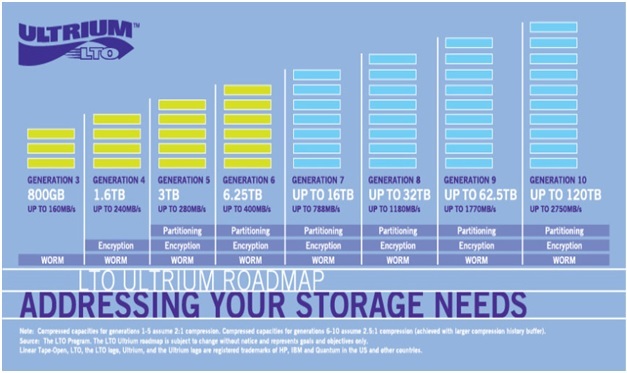
LTO Specifically for HPE NonStop Customers from Tributary Systems:
Tributary Systems supplies LTO 6 Tape Technology to NonStop customers, including those with the latest NonStop X Servers!
Tributary Systems, along with our partners at NonStop, continue to supply LTO 6 Tape Devices for NonStop NS and NB systems running the J-Series operating system, and for the new NonStop X systems employing the L-Series operating system.
The LTO 6 is available in three models:
·
M8801A Rack Mount 24 Cartridge ACL w/FC interface·
M8802A Table Top 24 Cartridge ACL w/FC interface·
M8805A Table Top Single Cartridge w/SAS interface



M8801A/M8802A 24 Cartridge ACL M8805A Table Top Single Cartidge
Important features LTO 6 Tape Drives offer include:
·
Dependability: Sets new standards for data integrity and reliability with a simple and robust design based on inherently reliable Linear Tape Open (LTO) time proven technology· High Capacity: Stores up to 6.25 TB per LTO 6 data cartridge assuming 2.5:1 compression
· Reliability: Protects your data with a simple, high integrity, data path including read and write dynamic random access memory
· Security: Fully supports ESKM (Enterprise Secure Key Manager) versions 2.1 and 3.0
· Compatibility: LTO 6 drives read and write to LTO 6 and LTO 5 media, and read-only LTO 4 media
· Speed: Minimizes interruptions with high speed and data rate matching that squeezes optimal performance from your NonStop Server
· Cost: Recall that LTO 6 drives can read and write to economical LTO 5 cartridges, offering a dollar per terabyte archiving cost that no VTL can match
· RVU Requirements: J06.18 or later, all L-Series releases
And remember, the LTO consortium of HP, IBM and Quantum has announced that this technology will continue at least through LTO 10, to be released sometime in the 2020’s, so the tape path you’re on now will continue for years to come!
Tributary Systems continues the availability of LTO 5…..
LTO 5 allows NonStop customers to read older LTO 3 media!
Lowest cost per TB method of data storage for the NonStop server!
Tributary Systems, for 20 years the premier OEM supplier of tape products for all HP NonStop Servers, along with our partners at NonStop, are pleased to announce the continued availability of LTO 5 Tape Devices for NonStop NS and NB systems running the H- or J-Series operating systems.
The LTO 5 is available in three models:
·
M8701A Rack Mount 24 Cartridge ACL w/FC interface·
M8702A Table Top 24 Cartridge ACL w/FC interface·
M8705A Table Top Single Cartridge w/SAS interfaceImportant features the LTO 5 Tape Drives offer include:
·
Dependability: Sets high standards for data integrity and reliability with a simple and robust design based on inherently reliable Linear Tape Open (LTO) time proven technology·
High Capacity: Stores up to 3.0 TB per LTO 5 data cartridge assuming 2.0:1 compression, or 72 TB with the full 24 cartridge capacity of the M8701A/M8702A.·
Reliability: Protects your data with a simple, high integrity, data path including read and write dynamic random access memory·
Security: Fully supports ESKM (Enterprise Secure Key Manager) versions 2.1 and 3.0·
Compatibility: LTO 5 drives read and write to LTO 5 and LTO 4 media, and read-only LTO 3 media·
Speed: Minimizes interruptions with high speed and data rate matching that squeezes optimal performance from your NonStop Server·
Lowest Cost: LTO 5 cartridges average $20 each, or $480 in media to completely populate the M8701A or M8702A ACL drives. There’s no lower cost method to store 72 TB of data, only $6.70 in media cost per TB! No VTL can match the low cost of LTO when it comes to data archiving.·
RVU Requirements: H06.25/J06.14 or laterContact your local HP NonStop Sales Representative to order LTO 5 or LTO 6 Tape Drives, they are in stock and ready for shipment now.
TANDsoft Introduces the SDI Toolkit for Sensitive Data Intercept
TANDsoft Inc.’s new SDI Toolkit™ protects sensitive data-at-rest by
intercepting NonStop database access calls, encrypting data written to
disk, and decrypting data read from disk. It supports Enscribe, SQL/MP,
and SQL/MX (coming soon), both native and non-native applications. No
program changes are required.
Who currently are SDI Toolkit users? They are some of the largest
NonStop security partners and customers. Combined with HP partner
security solutions, with HP Security Voltage, or with in-house security
solutions, SDI Toolkit offers additional encryption and tokenization
capabilities.
SDI/Log, a companion product, provides intelligent logging of all access
to sensitive data. SDI/Log also does not require any application
modifications, works with all NonStop programs, and can be used by
auditors for regulatory compliance.
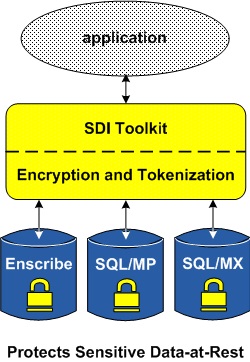
TANDsoft is a global provider of innovative HP NonStop software
solutions for use in time virtualization, application modernization,
security, and business continuity. Our intercept technology is used by
many NonStop customers to enhance legacy application functionality with
no program modifications. Our products are easy to install, easy to use,
and are certified on NonStop X. TANDsoft offers free software trials and
is always competitively priced.
In addition to the new SDI Toolkit, TANDsoft solutions include the
OPTA2000 virtual clock- and time-zone simulator; FileSync for automatic
file synchronization, replication, and data deduplication;
the OPTA suite of interception and trace utilities (OPTA-Trace Online
Process Tracer and Analyzer, Recycle Bin, Low Pin Optimizer, and EMS
Alerts Online Startup and Termination Capture Utility); Stack Monitor,
which alerts developers to the impending threat of a stack overflow;
Command Stream Replicator, which logs and automatically replicates TMF-audited/unaudited
FUP, SQL/MP and SQL/MX DDL structure and other environment changes to
target systems; AutoLib, which automatically loads a user library or a
DLL for executing processes; the Enscribe-2-SQL and TMF-Audit Toolkits
and the Enscribe-2-SQL Data Replicator, all of which offer flexible,
affordable alternatives to more expensive conversion products or manual
conversion techniques; and E2S-Lite, which permits efficient, low-cost
Enscribe modifications without the need to change a program’s source
code.
TANDsoft will participate as an exhibitor at the NonStop Technical Boot
Camp in San Jose, California, USA, from November 15th thru 18th . Visit
us at Booth #14. Our Enscribe to SQL Migration Forum on LinkedIn is at
220 members and counting.
For information about TANDsoft solutions, contact Jack Di Giacomo at +1
(514) 695-2234.
The company is headquartered in Beaconsfield, Quebec, Canada. UTC/GMT -4
(Eastern Daylight Time)
www.tandsoft.com
The FedEx of file movement …
Our support of user groups’ meetings and events continues, with the latest, the event outside Washington D.C. in support of the Mid-Atlantic Tandem User Group, MATUG, taking place just last month. Having an opportunity to update the community on all that DataExpress can accomplish is an important aspect of our business today as it continues to surprise us that many people in the NonStop community do not realize that we play as important a role as we do inside very large Financial Institutions (FIs). Whenever talk amongst user group members turns to matters of real time processing it is often forgotten that in addition to the tasks necessary for solutions to perform real time operations the FIs also do have obligations to ensure critical financial information makes it to destinations apart from the data center.
Surely, moving files around is so twentieth century? Haven’t we evolved to where in today’s always-on, highly-connected, world information can simply be accessed by any authorized party at any time? Just give us browser or app access and it will be all we need? Turns out that no, there’s just so many reasons why industry and government agencies need information and it has to arrive in a prescribed manner, precisely at the right time. It’s no surprise then that with the solution we provide and with the mandate that files just have to arrive on time or else, so few within the NonStop community are even aware of DataExpress quietly going about its business.
The analogy with what happens in the real world is obvious, but only recently saw the light of day during discussions with a major third party. In the world of online commerce, so much business is performed online that many parties are oblivious to the fact that in the end, transactions result in real items being moved between parties. You only have to drive on any major highway to see the lines of trucks transporting goods between cities. One of the trucking companies you simply cannot miss is FedEx, as their ubiquitous paint schemes are familiar to everyone on the planet and depending on where you are these FedEx trucks can be many articulations long. Yes, there’s a mountain of goods shipping every day as a result of our online world.
Now, think of DatExpress as providing the equivalent of services to FedEx. Business needing to ship a file can tell DatExpress to come pick up the file or, just as easily, they can drop off a file with DataExpress at any time. Irrespective of the manner in which a file is delivered to DataExpress – think both push and pull models as being supported, as you can push a file to DataExpress even as DataExpress, in turn, can pull a file – DataExpress “locations” end up with a multitude of files. And these files may be destined to one or more end point destinations, with some files franked express that will on-ship immediately whereas others may be franked to ship at a specific time. All just part of the “service” provided by DataExpress.
DataExpress is much more than just a file transfer system. Ship it via Secure FTP (sFTP), Connect: Direct (Network Data Mover), whatever – today DataExpress can work with them all. But it’s the special sauce that is unique to DataExpress, and by special sauce, it’s all about adding protocols that better inform DataExpress about the arrival of files at destinations and whether there were any issues along the way. It’s all about automating the process fully and about ensuring a measure of security and reliability that can be missing from many file transfer products. It’s all about ensuring the data center manager can sleep at night without worrying about operations forgetting to initiate a transfer.
There’s going to be even more files being moved with the arrival of the NonStop X family of systems. We expect that with the new, lower priced entry level system, additional transaction processing environments will emerge with a whole new category of distributed processing being implemented – all requiring even more files to be moved. Like everybody in the NonStop community today, we are staying close to HP to see just how successful the introduction of the new HP Integrity NonStop NS3 X1 system proves to be. Anecdotally we are hearing that orders are being placed by vendors for systems as test systems, but increasingly we have become aware that these systems are reaching the shores of countries as far away as Japan and even deep inside South America.
Of course, HP set a precedent for the NonStop vendor community following the success of the original HP Integrity blade systems based on Itanium chipsets that led to just about every user upgrading from older Himalaya K and S Series systems, but the early indications are that current NonStop users may be holding back even as new customers find cheaper, industry standard systems more to their liking – even the smaller FIs will see value in an affordable NonStop system given the retreat from the marketplace of nearly all other fault tolerant alternatives.
We will be watching the progress of NonStop X and will be attending even more events in the future while we maintain a dialogue with those NonStop users we work with today. And yes, we look forward to seeing you at the NonStop Technical Boot Camp in November! Our fingers are crossed of course given the opportunity NonStop X presents to business but as you look at your options for deploying NonStop X either as a replacement system or in a distributed, regional / operational manner, we sure would like to hear from you as we have to believe, you will still have files you just have to move, securely and in a timely, automated manner!
Contact Info:
1401 Shoal Creek, Suite 250,
Highland Village, TX 75077
email:
Sales:
972-899-3476
Corporate: 972-899-3460
BITUG News – BIG SIG 2015
This year the BITUG BIG SIG will be held at Trinity House http://www.trinityhouse.co.uk/venue_hire/virtual-tour.html in Central London.
On the 3rd December there will be an education day at HP Offices in Wood Street where we'll be taking an in-depth look at the new NonStop X covering “NB to NSX Migration”. Register now for the 2015 BITUG Education Day https://www.eventbrite.co.uk/e/bitug-bigsig-2015-education-day-tickets-17881567249 – there a limited spaces.
On the 4th December we will be at Trinity House – below is the draft agenda, this agenda may be subject to change. Register Now for the 2015 BIG SIG https://www.eventbrite.co.uk/e/bitug-big-sig-2015-tickets-18433932388 – there a limited spaces.
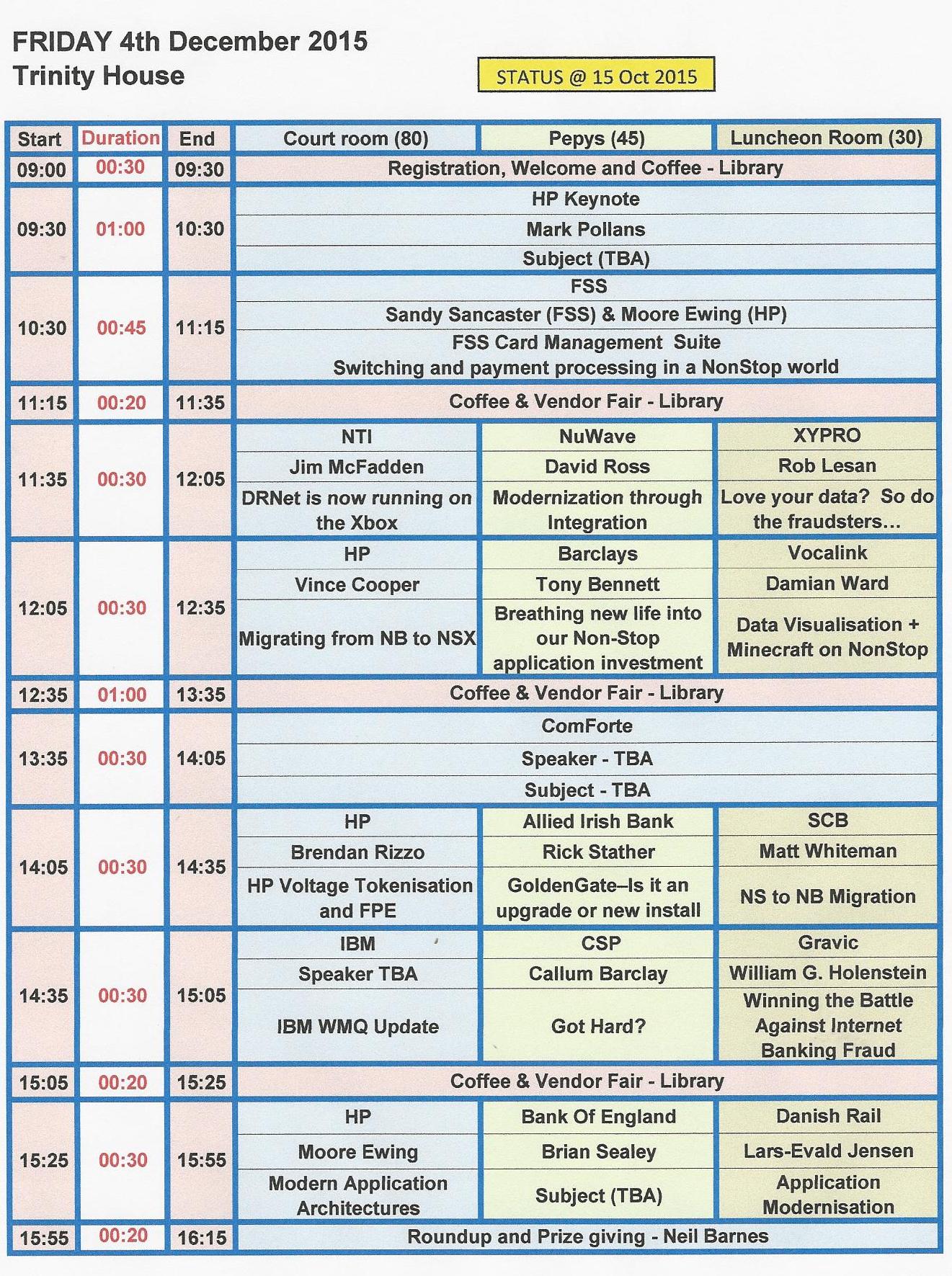
More details will be available in the BITUG Autumn Newsletter which is scheduled for issue in the next few days.
The BITUG Committee look forward to seeing you all on the 3rd and 4th December.
Musings on NonStop!
October, ‘15
The
opinions expressed here are solely
those of the now self-employed author
There may be many reasons that
draw us to checking the discussion groups active on LinkedIn and for
many of us it’s not just for purpose of networking as we look for our
next job, but rather a useful source of information on a variety of
topics. There are still a lot of discussions that are purely
promotional, and I am among those who use LinkedIn in this fashion, but
even with the discussions I start, every now and then a dialogue opens
up. Mix in the information that is readily available in numerous
community and vendor blogs as well as what is published in journals like
The Connection (not forgetting this Tandemworld newsletter as well) and
the NonStop community is very well served with information on
practically every topic of importance to IT these days.
One such exchange that has me interested started in the LinkedIn group,
Real Time View. Essentially a counterpart to the NonStop community
blog site of the same name,
Real Time View, and started with the purpose of encouraging an
exchange of comments (and it’s proved successful on this point through
the years of its existence – if you haven’t joined this group, you may
want to consider doing so). In support of a recent post to the NonStop
community blog, Real Time View,
How many DBAs does it take to change a light-bulb should it not be
NonStop? there has been an open discussion on clouds, NonStop an
integral part of a cloud, and NonStop SQL available as a
Software-as-a-Service.
It isn’t often that we see participants well-versed in technology and
NonStop join in the debate but once I saw fellow Aussie and now resident
in America (and former Sabre chief architect), Alan Walker, I felt
compelled to give it more than a casual response. What Alan mused about,
“It would be nice if there were a cloud-hosted service that had a
NonStop DB.” Then by way of an additional explanation, Alan added, “A
lot of the NoSQL proponents talk about the flexibility of just adding
whatever they need to the DB on-the-fly. This wouldn't be a concern in
SQL if it could be more dynamic.”
In response to my initial follow-up, Alan then explained that, “The challenge to using NonStop for cloud hosting is to slice up and manage portions of the cluster, so that it can be billed to customers.” He also wrote of how he had, “Looked into this years ago to figure out if I could monitor the usage of transactions as they flowed through the system, and I couldn't figure out how to time the usage of the disk process back to the caller.” Furthermore, added Alan, “Apportioning storage is easy to do, but it's not clear (to me) how you could limit a customer (of NS SQL on NS inside a cloud) to some portion of the system.”
At the time of writing this month’s Musings, this discussion is still ongoing but what I really like about the exchange on LinkedIn is that there’s many other members of the NonStop community also reading the exchange and independent of any outcomes, are beginning to think about NonStop populating clouds. And this is the more important message to come out of this exchange. Yes, there’s difficulties when it comes to supporting the degree of “elasticity of provisioning” users of clouds expect today but like everything else we have to reckon with in IT, there’s likely answers to this out there. As a community we have a lot of really smart people so a couple of them I am sure will take up the challenge.
The lead will most likely come
from solutions vendors as they have the most to gain. One vendor that
has been promoting SaaS and Cloud Computing is OmniPayments, Inc. The
first the NonStop community heard of this was in the Jan – Feb, 2015,
issue of The Connection with the appearance of the article,
Payment-Card Transaction Switching Via The Cloud “OmniCloudX is a
NonStop-server cloud that can host financial-transaction switches for
multiple medium-sized retailers at an affordable price,” said
OmniPayments, Inc. CEO Yash Kapadia. “OmniCloudX transaction-switching
services start as low as $5,000 per month.”
“As is the case with large retailers, many mid-size retailers,” Yash
then noted. These mid-size retailers “Would like to reduce their
transaction costs by providing their own financial-transaction switches.
However, the expense of purchasing stand-alone switches and then
managing the switch operations does not justify the potential savings.
The answer is to turn to the cloud. If financial-transaction-switching
services are offered by a cloud, the retailer has to pay only for the
amount of CPU resources, storage, and networking that it uses – clouds
are operated on a pay-for-use basis.”
True, the reference to clouds in this instance may be creative on the
part of Yash but it is legitimate as the cloud providers we see today
all started out offering SaaS solutions, even Salesforce.com, perhaps
the most famous of these providers. By starting with a SaaS solution,
the pricing is greatly simplified as it becomes a case of having tools
in place to charge by user and this is something OmniPayments has done.
“OmniPayments recently introduced OmniCloudX,” said Yash, in The
Connection article, and emphasized that, “OmniCloudX is not a general
cloud offering for running customer applications. Rather, it is a
Software as a Service (SaaS) cloud that specifically provides
financial-transaction-switch cloud services via HP NonStop servers.”
A short time ago, back on August 30, 2015, I blogged about this on the BAI Online Community site in the post Putting data back into data processing ... I made the observation about how Yash has a history of pushing the envelope. “After all, how many payments solutions’ vendors can say that they provide product and services, where services include the running of the solution (in this case OmniPayment’s products) as a SaaS from out of a cloud (in Yash’s case, deployed on OmniPayments premises scattered around the Americas).” Not missing an opportunity with the BAI audience, I then added how, “The make of the cloud is such that it’s anchored on HP NonStop systems that today are transitioning to the new NonStop X family of systems that utilize the Intel x86 chips. So it’s not completely unexpected to hear that Yash is looking more closely at the benefits data analytics can provide, particularly when it comes to detecting fraud and effectively dropping the boom on the bad guys.”
LinkedIn, The Connection, association blogs such as that hosted by BAI all help ensure critical business information is on hand to any IT group looking for news about the adoption of new technologies within the NonStop community. It’s early days, yet no enterprise should rule out a place for NonStop even in the most generalized of cloud implementations and with hybrid in test, I expect that there will be more news to come about NonStop in the clouds. For the moment, there’s growing talk of possibilities as well as the first steps being taken towards greater cloud leverage and with this the NonStop community shouldn’t be shy about talking of clouds to their peers in IT. Who knows, there may come a time where there isn’t a single vendor presentation without the option of cloud deployment and that, as a community, we should all be rather pleased to hear!
Richard Buckle
Founder and CEO
Pyalla Technologies, LLC
Email:
richard@pyalla-technologies.com
Following my blogs? My web publications? My discussion Groups?
Check out (or
copy and paste to your browser):
Real Time View
at
http://www.itug-connection.blogspot.com/
…. And check out the Group on LinkedIn, Real Time View
comForte at http://blog.comforte.com/
…. And check out the Group on LinkedIn, comForte Lounge
ir.com Payments and Infrastructure at http://www.ir.com/blog-pay/
…. And check out the Group on LinkedIn, realtime.ir
WebAction.com at http://webaction.com/blog/
….
And check out the group on LinkedIn, Data Driven Apps
ATMmarketplace at
http://www.atmmarketplace.com/blogger.php?id=130763
… And check out the Group on LinkedIn, ATM Industry Association
buckle-up at http://www.buckle-up-travel.blogspot.com/
…. And check out the SubGroup on LinkedIn, Pyalla Track Days
comForte closes best financial year in company history
Wiesbaden, October 27, 2015 - comForte 21 GmbH ('comForte'), a global provider of connectivity, middleware, and security solutions for the HP NonStop platform, announced today that it had the best financial year in company history. comForte's financial year ended 30 September 2015.
'We are very pleased with the results per end of our fiscal year', says Michael Weilbacher, CFO and Head of Sales worldwide of comForte. 'we exceeded all our financial targets and achieved a growth of more than 20% compared to the previous year. This is a result of comForte's continued focus in investing in the development of software products in payment security, application modernization and connectivity.'
comForte's flagship software solution for tokenization of sensitive data reached a new milestone in the market with 10 customers deploying SecurData worldwide. The underlying tokenization algorithms were granted patents in Europe and the USA.
Prognosis Continues to Deliver Value for NonStop X Users
Author: Andre Cuenin, President, Americas and Europe at IR
IR has been providing value to the NonStop community for more than 25 years. Many people view IR’s system and application performance management solution, Prognosis, as the solution of choice for NonStop environments. While we’re proud of what we’ve accomplished, we haven’t stopped working diligently to expand the value we bring to NonStop users.
“If you can’t measure it, you can’t manage it” is certainly true, but these days actual measurements are harder to truly achieve as a result of the ever-increasing interconnectivity of systems and applications. Today, more NonStop users of Prognosis are leveraging IR’s capability to run and manage performance of adjacent systems. This includes utilizing Prognosis for open systems like Unix, Windows or Linux (including its application stack), or to get visibility into contact centers supporting all types of payment processing operations, including credit and debit cards, mobile payments and other emerging technologies.
Monitoring a mix of applications running on NonStop is all well and good, but these days we are being asked to do much more than that. IR customers expect Prognosis to help them in three key areas: 1) application performance monitoring, 2) operational maturity and optimization, and 3) business intelligence. IR continues to invest in all of these areas to ensure Prognosis remains the solution of choice of the NonStop user community.
With the growing adoption of the NonStop X architecture we expect to see more integration of heterogeneous environments that will share workloads based on service levels and availability requirements. As much as this vision might sound enticing from a cost/value perspective, it will undoubtedly increase complexity, which in itself is a driver for operational challenges. The classic saying “the chain is only as strong is its weakest link” applies more than ever. Every piece of technology added is another link in the chain. Prognosis is perfectly positioned to manage these complex hybrid environments.
For example, IR has recently been working with a large global retailer migrating from NonStop to a NonStopX hybrid environment. Prognosis application and platform monitoring is ensuring that every step of the migration goes smoothly, while customized dashboards and reporting give the client the visibility they need to make critical business decisions directly tied to their ongoing global expansion.
Want to learn more about Prognosis for Payments? Visit IR.COM and look under the tabs for both Payments and Infrastructure. IR will also be participating in upcoming user events including the NonStop Technical Boot Camp to be held in San Jose in November, and I am sure we will see many of you there.
As a company, IR remains firmly committed to the NonStop platform so be on the lookout for further updates on products and features as we track the NonStop product roadmaps closely over the coming months. Please join us on November 12 for a NonStop X webinar that will share insight into how Prognosis can support your NonStopX project.
Andre Cuenin
andre.cuenin@ir.com
+1 303 390 8732
comForte at the NonStop Technical Boot Camp in San Jose, Nov 15-18, 2015
comForte is a Diamond Sponsor yet again this year and we are looking forward to provide you with lots of exciting content at the Technical Boot Camp.
First off are the pre-conference workshops which will be held on Sunday Nov 15:
Workshop I: 8-10 am - A PoC for a hybrid application built on the Yuma Infiniband stack
Speakers - Brad Poole, Senior Solution Architect, comForte, Mike Rice, HPE, Justin Simmonds, HPE
Abstract - The workshop will consist of three presentations: the first will talk about the Hybrid architecture and potential use cases (Justin Simonds). The second will explain the Yuma/Infiniband architecture (Mike Rice). The third will talk about the results of the comForte Proof of Concept based on the early version of the Yuma product, it will also discuss comForte product plans based on its existing product set and the new possibilities (Brad Poole).
Workshop II: 10-12am - Payment Security with tokenization on NonStop and the Enterprise – we show you how it’s done!
Speaker - Chris Riffe, Senior Solution Architect, comForte
Abstract - Learn from our experience helping customers to implement tokenization, and at the same time, limit the overall impact, risk and downtime. We have the benefit of lessons learned from successful production installations, and we understand the importance of keeping your system running NonStop while implementing SecurData.
We are very happy that Michelle West of TD Bank, Canada, will join us at Boot Camp to give a detailed account of how tokenization has been implemented on TD Bank’s Nonstop servers to protect PAN data. She will explain the banks requirements and why tokenization was selected as the best way to protect data in their environment. The main focus will be the implementation process they have used to insure a successful project.
The exact date and time for this presentation - 'Mission impossible? Protecting BASE24's data-at-rest with tokenization and without code change' - is yet to be confirmed, so please check the session pages for an update.
Please do come and visit our stand in order to discuss your requirements with our executive, sales and technical teams.
See you in San Jose!
Third Data Corporation
Secure Data and Accelerated Applications
888-301-2431 / sales@thirddata.com
Third Data Corporation provides numerous products which can reside on HP Nonstop and other HP hardware platforms. In addition we provide custom high performance software design and development for our clients. Don't forget to download the latest version of Sysbusy. It's FREE at www.thirddata.com/dwnlds.html
Accelerated Development of High-Speed Applications
NxLib
– NxLib provides a platform and utility libraries for developing a high performance multi-threaded applications on NonStop Guardian. The platform provides threading, queuing and network capabilities. This enables development of an application written single threaded style to perform as multi-threaded. Extensible command processing and help are supported. Development time can be cut to a fraction of the time it would normally take. This results in fast application development with consistent look and feel across multiple projects.FastBuild Switch
– When building a switch be it ATM-POS, Wire Transfer, EFT, Medical, or any other type of data that needs to get from one place to another, you are usually faced with three choices. Take an existing package and modify your system to match it. Get the vendor to “enhance” their system to meet your needs. Write a new system from scratch. The FastBuild Switch integrates with your existing system, or if you are building from scratch gives you a great start. The switch is also built around the latest HP technology to maximize performance. It integrates several of our other products to maximize cost savings and security in a fault tolerant manner. In a cross platform environment it also runs on other non-Guardian HP supplied platforms.Securing Data at Rest
SecureStore
– If you are security conscience trying to become compliant (PCI, HIPAA, etc) then you know that you can not leave sensitive data readily viewable. SecureStore encrypts the data for your application so that you can become compliant. As part of disaster recovery your data is sent to multiple locations so it will be available when you need it. As a bonus for those having trouble with Guardian 4K limits there is no record size. It can also integrate with SQL systems (SQL MX/MP, Oracle, Postgres etc).TokenStore
– TokenStore supports multiple formats. From generation and storage of Tokens per EMV specifications to translation and non-storage of full or partial customer PCI data.Securing Data in Flight
NxSSL – NxSSL is an SSL proxy which may be used to provide SSL encryption and authentication services to TCP/IP connections. It provides full support for certificates and multiple encryption standards. It has been carefully tuned to provide the highest performance available for any NonStop SSL connection.
NxWeb
– A high performance web server which provides support for NxLib applications. It also can be used without NxLib. It provides for secure connections, virtual domains, full http support and interfaces to pathway and IPC communications.
comForte's Limited Edition 'HP NonStop for Dummies' Book!
This book is for anyone with an interest in HP NonStop systems. This book is for you if you're new to the platform, have spent many years working with it, if you manage people or IT systems, or if you're a system operator or developer on/for the HP NonStop platform.
|
Get the book and … |
|
|
|
· Learn more about HP NonStop systems - a lot has changed in the past few years · Find out why the platform is unmatched in the areas of high availability and linear scalability - all out of the box · Discover how to develop new applications on the platform and how to modernize existing ones - all using modern and standard technologies · Explore ways to better integrate your HP NonStop systems in the Enterprise IT infrastructure |
If you would like to receive a free copy of the 'HP NonStop for Dummies' book please register at … http://www.comforte.com/ns4dummies
Gravic Announces New Shadowbase Website
Please visit our new website at www.ShadowbaseSoftware.com! You will see major improvements in both high-level and technical content and graphics, with easy-to-use “drill-down style” page navigation under six major tabs: Solutions, Products, Support, Publications, About Us, and Contact Us, and a convenient site map at the bottom of each page. Our home page focuses on our four major solutions: Business Continuity, Data Integration and Synchronization, Application Integration and Utilities, all linking to in-depth information. Located under the Publications tab are our popular white papers, case studies, and articles, all categorized by Shadowbase solution type, as well as recent news and newsletters. Other highlights include expanded pages on Shadowbase products and support/service. We hope that you will enjoy visiting and using our new site! Note, we are no longer updating our old website and will retire it within the next year, so please change all references you may have from www.Gravic.com/Shadowbase to www.ShadowbaseSoftware.com.
Gravic Presents HP Shadowbase Sessions at Connect NonStop T.B.C.
Please stop by Gravic Booth #9 at the NonStop Technical Boot Camp on November 15-18 at the Fairmont Hotel in San Jose, CA. We look forward to meeting you at the show and
sharing ideas regarding how the HP Shadowbase product suite can provide solutions to your most pressing business issues for business continuity, data integration and synchronization, and application integration. We hope to see you at one or all of our presentations:
· HP NonStop Business Continuity Product Suite Overview, Featuring HP Shadowbase, Mark Pollans, Paul J. Holenstein
· HP Shadowbase Data and Application Integration Solutions with Use Cases, Mark Pollans, Paul J. Holenstein
· Shadowbase Product Suite Update, Paul J. Holenstein, Keith B. Evans, John R. Hoffmann
· Case Study: Vodacom’s One Year Recovery, William G. Holenstein
· Winning the Battle Against Internet Banking Fraud by Leveraging HP Shadowbase Streams Real-Time Data and Application Integration, Keith B. Evans
Gravic Presents Shadowbase Case Studies at October Events
Gravic personnel recently attended two October events, The Payments Knowledge Forum in London, and the CTUG Fall Conference in Toronto. Attendees enjoyed our presentations: Vodacom’s One Year Recovery and Winning the Battle Against Internet Banking Fraud by Leveraging HP Shadowbase Streams Real-Time Data and Application Integration. Please contact us if you are interested in discussing these presentations’ content or having us present them to you or your colleagues.
To speak with us about your data replication and data integration needs, please visit us at www.ShadowbaseSoftware.com, email us at SBProductManagement@gravic.com, or call us at +1.610.647.6250.
HP directly sells and supports Shadowbase Solutions under the name HP Shadowbase. For more information, please contact your local HP account team.
Please Visit Gravic at these Upcoming 2015 Events
|
Connect HP NonStop TBC San Jose, CA, 15-18 November |
|
|
|
HPE Discover 2015 EMEA London, 1-3 December |
|
|
|
BITUG BIG SIG London, 4 December |
|
|
Please Visit Gravic at these Sites
comForte at events near you in 2015 and 2016
|
Connect NonStop TBC |
15-18 Nov 2015 |
San Jose, CA, USA |
|
BITUG BIG SIG |
4 Dec 2015 |
London, UK |
|
DUST |
9 Dec 2015 |
Scottsdale, AZ, USA |
|
SUNTUG 2016 & Golf |
4-5 Mar 2016 |
Tampa, FL, USA |
|
International GTUG |
18-20 Apr 2016 |
Berlin, Germany |
Please get in touch if you would like to arrange meetings with our team at any of these events.
NonStop Technical Boot Camp 2015

Register now!
www.etouches.com/nonstopTBC2015
2015 NonStop Technical Boot Camp Attendee Registration: $1295
Pre-Conference Seminar
Registration: $150
SPECIAL EVENT!
Guest/Spouse Pass for Evening Events and Receptions: $200
Hotel info:
Fairmont San Jose 1-800-346-5550
Available online: (see Travel link)
34 Sponsors:
|
4Tech Software |
ACI |
|
Ascert |
BlackWood Systems |
|
Canam Software |
comForte |
|
Crystal Point |
CSP |
|
ESQ |
ETI-NET |
|
FSS Technologies |
Gravic |
|
HP NED |
HP Voltage Security |
|
Idelji |
INDUCTUM SRL |
|
IR |
Lusis Payments |
|
Marshall Resources |
Merlon |
|
Network Technologies |
NuWave |
|
OmniPayments |
Oracle |
|
QSA |
Resource 1 |
|
RiverRock Software |
Striim (WebAction) |
|
TANDsoft |
TCM |
|
Third Data |
TIC |
|
Tributary Systems |
XYPRO |
|
|
|
The Partner SIG looks forward to seeing you soon!
Kathy Wood
NonStop Partner SIG/Vendor Chair
Tape Catalog Optimizer (TCO) from QSA Enterprises makes file recovery a piece of cake.
Restoring files from the DSM/TC catalog can be a bit of an adventure.
· Issue Mediacom commands to find what Tapefile and Generation and Filecat contain the files you want to restore. This will probably produce a large number of records which will have to be listed to the spooler. Find the spooler file and determine which copies of the files you want to retrieve and get the Filecat, Tapefile and Generation from the listing.
· Create a Tapecatalog Define with the DSM/TC database information acquired in the previous step.
· Issue the Restore command using the proper syntax for the required restore options. This can be a little confusing when restoring SQL objects.
· To verify the tape volume has been mounted, at least one (but probably more) Mediacom Status Tapedrive and/or Status Tapemount commands must be performed.
· When the restore has completed you have to find the output in the spooler to examine it to determine if the restore was successful.
Things get simpler with TCO.
· Search the DSM/TC database using the TCO Disk File Search window. TCO provides more search options than Mediacom, such as Date Modified. Select the files you want to restore, right click and select Restore Diskfiles from the pop-up menu. The Diskfile Restore window appears populated with all of the DSM/TC related information.
· Use the mouse to select the Restore options (hover the mouse pointer over an option displays a description of the option) or select a Restore Profile to auto-select a predefined set of options and values. Click the Start Restore button.
· The integrated Tape Drive Monitor shows the mount request and tape mount activity in real time without any user interaction. The Restore Progress window appears to show the Restore Output as it occurs. What could be simpler?
Besides the ease of use issues, TCO reduces the amount of expertise required to get a Restore going. There is no need to know how to assemble a Tapecatalog Define and with Restore Profiles it isn’t even necessary to know the Restore options. Just click click click, watch it go and you’re done.
TCO provides point and click efficiency for DSM/TC (Mediacom) configuration and querying, and provides logging and alerts for database modifications. Great stuff on its own, but the ease of retrieving files and objects frees your technical people from having to get involved, dramatically reduces the amount of time it takes to start the restore and reduces the chance of human error.
We will be at the NonStop Advanced Technical Boot Camp in San Jose, CA in November. Stop by and we’ll show you how easy this is and the other features of TCO and our other software offerings.
If you can’t make it to San Jose you can get more information about Q/Tos and our other solutions by visiting our web site at WWW.QSA.COM, email us at info@qsa.com or give us a call at 703-771-9447.
CSP - A NEW DAY HAS COME FOR NONSTOP SECURITY

We recently sent out a notification about our upcoming announcement to be made at NonStop Technical Boot Camp in San Jose, CA this November. As one of the largest projects ever undertaken by CSP, we are very excited to share the news that a New Day has come for NonStop security.
We hope to see you at the CSP booth, and encourage you to attend the exciting and informative presentation on our new solutions which include an expert approach to security hardening in order to reduce the chance of an insider attack. The presentation entitled "Got Hard ?" will describe how CSP has applied the latest technological advances to hardening NonStop servers with a major focus on NonStop X, Open Systems and OSS.
As an innovator and leader in the NonStop security industry, CSP has been serving the community for over 27 years, helping clients secure their NonStop systems. We understand how critical it is to keep up with the changing times and technologies, and strive to be a step ahead.
CSP is proud to be a platinum sponsor for the upcoming 2015 NonStop Technical Boot Camp at the Fairmont San Jose Hotel (Nov 15-18, 2015), and welcomes you to the event.
We look forward to seeing you at The Fairmont!
Regards,
The CSP Team
For more information on CSP solutions visit www.cspsecurity.com
OmniPayments is Extending Its NonStop X Family
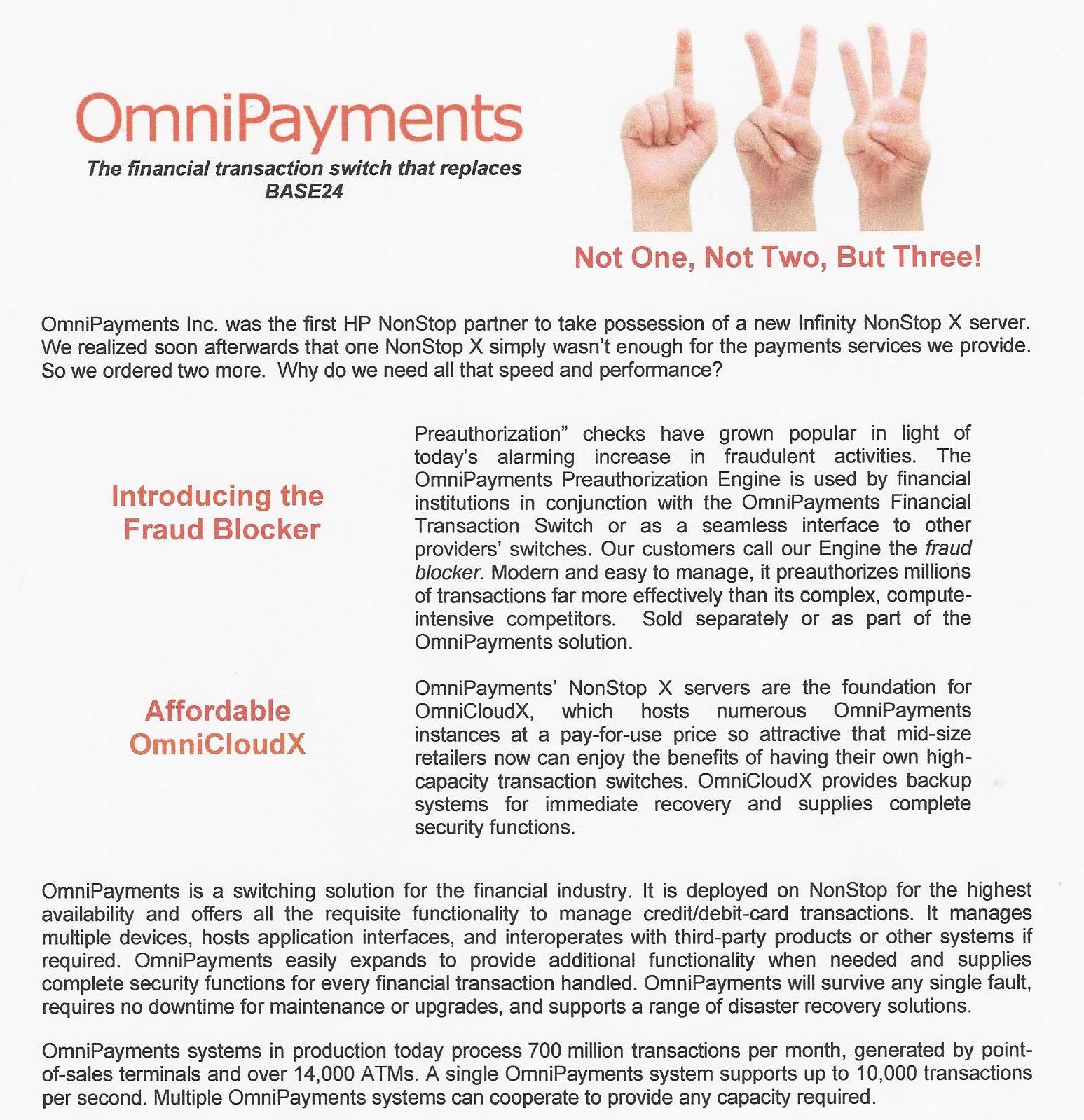
OmniPayments Inc. (www.omnipayments.com) is the product arm of Opsol Integrators In. a Leading HP NonStop System Integrator. For further information, contact Yash Kapadia at +1 408-446-9274 or at yash@omnipayments.com. Join OmniPayments at the NonStop Technical Boot Camp in San Jose, California, USA, from November 15th thru 18th. We are Table #4.
Performance Analysis: Why go outside?
Our segment of the IT industry (financial transaction processing) is unique. It’s all about availability. While other segments are striving to achieve a fail-over time of less than an hour, we are used to achieving sub-minute and in the best cases sub-second recovery. For our segment the stakes are too high. It’s not unusual for a system to be handling tens of thousands of dollars of transactions per second. As an industry we’ve made the investment in redundant hardware, data synchronization across multiple sites, and the associated software to make it all happen.
But redundancy is not enough to achieve availability. Every holiday season we hear of sites which have failed. Many if not most of those failures are capacity-related. There is no reason for this. Our 25 years in the industry have taught us that those failures can be anticipated and avoided. Here are some of the reasons that you should consider our Ban Bottlenecks service for your site.
You’ve had an outage. Unfortunately, this is proof that your current methodology is not working. This is the best reason to talk to us. We will show you how to stabilize your system and prepare it for the workload which will stress it in the future.
The “Performance Group” doesn’t understand your system or your market. As I’ve already mentioned, our requirements for availability are unique. Our systems can’t suffer an outage. Unfortunately, major IT departments have performance groups who either don’t understand or won’t devote the resources to keep ahead of the curve. They typically watch the “usual suspects” which include CPU and perhaps disk. Our philosophy is to watch everything, all the time, and correlate it to the transaction stream. Every minute is important in our world. Red, yellow, or green squares on a screen or waiting for an alert just doesn’t cut it.
You don’t have the time. Many shops have the tools and the expertise, but simply don’t have the time to collect, correlate, analyze, and project the numbers. This is especially true for those shops running multiple nodes. It’s hard enough to watch everything on only one system. Doing the same, to the proper level of detail and breadth of components covered, is simply too much for your key individual. Over the years we have developed tools and techniques for comparing and contrasting systems. We’re very successful in finding the “needle in the haystack” across multiple or even hundreds of systems.
You don’t have the expertise. Sometimes smaller shops simply can’t afford to dedicate and train a performance specialist on the architecture. We take over that function for your shop. One of our clients in this mode stated “I don’t even have to know the questions to ask. Ban Bottlenecks tells us.” We are your performance partner.
Cost: When you work with us you will find that our fixed-fee approach is less than your current software cost, training cost, and certainly staff time cost. Our software is bundled into the service.
For the last 25 years Ban Bottlenecks has been successful in collecting, integrating, and analyzing all the factors affecting application availability and performance. We provide weekly reports covering your system 7x24, with a 2-year history. If the goal for your system is proactive performance and capacity management, contact us.
1.415.256.8369
Availability Digest Explains How Japanese Data Centers Survived the March 2011 Earthquake
In the September 2015 issue of the Availability Digest, we described
the anticipated danger of a long overdue and catastrophic earthquake
devastating the Northwest Coast of the United States. The last massive
earthquake in the region, a magnitude 9.0, was in January of 1700, long
before the U.S. became a country and when few inhabitants were there to
experience it. Over three hundred years later, the population has risen
into the millions along with the thousands of companies that employ them
and thousands of vulnerable data centers. How prepared are those
companies today when no one was around for the last big earthquake? Out
of sight, out of mind.
Japan, on the other hand, experiences deadly earthquakes all too
frequently. After all, the country sits on the joint of four different
tectonic plates. In response, Japanese data centers take their survival
very seriously, which is why the majority of them endured the 11 March
2011 Great East Japan Earthquake with little if any damage.
http://www.availabilitydigest.com/public_articles/1010/japan_earthquakes.pdf
“Japan’s Data Centers Survive Their Big One” discusses the steps that
Japanese data centers have taken to minimize the impact of the country’s
earthquakes and tsunamis.
From the obvious – don’t locate both data centers and their backups in
the most vulnerable areas of the country...
...to the measured – raised floor systems, floor-level isolators,
equipment secured firmly to the floor...
...to the forward thinking – free-air cooling instead of water coolers,
Japan’s data centers survived March 11th because sound disaster-recovery
plans were in place and were followed. It remains to be seen if the U.S.
Pacific Northwest-based data centers of Microsoft, Boeing, Starbucks,
Amazon, and others will endure as well.
The Availability Digest offers one-day and multi-day seminars on High
Availability: Concepts and Practices. Seminars are given both onsite and
online and are tailored to an organization’s specific needs. We also
offer technical and marketing writing services as well as consulting
services.
Join Digest Managing Editor Bill Highleyman at the upcoming NonStop
Technical Boot Camp in San Jose, California USA, November 15th thru
18th. Bill’s breakout session is titled “The Fraud Blocker: Catching the
Wrongdoers.”
Published monthly, the Digest is free and lives at
www.availabilitydigest.com. Please visit our Continuous Availability
Forum on LinkedIn. We’re at 712 members and counting. Follow us as well
on Twitter @availabilitydig.
XYPRO – Security Intelligence – Intercepting “Low and Slow”
Security has been a lifelong passion of mine. Growing up, I constantly pushed the envelope of what was possible. This was strictly for “research” purposes of course. I would spend a lot of my time after school (and sometimes during school) seeing what systems I could gain access to, discovering obscure security “features”, using my Svengali-like charm for social engineering or exploiting just plain security negligence . This was for no other reason than self-satisfaction, to cure a little bit of boredom and, to obtain some online fame. It was fun. I felt cool. I WAS that kid in my parent’s basement, but as I was sitting in my parent’s basement banging away on my keyboard, I was pwning your tech! The dot-com bubble was just forming and n00bz didn’t stand a chance.
I look back at the wealth of experience gained from the need to alleviate boredom in my early life and wonder how trivial it would have been for someone to notice what I was doing and to shut me down, but in the late 90s, security wasn’t just an afterthought – it was virtually non-existent. No one was keeping an eye out whether the system was being used for anything other than for what it was originally intended.
MTTD in Today’s World
Fast forward twenty years and security is at the forefront of everyone’s minds, yet common security oversights of best practices and negligence are still very much part of today’s landscape. The Mean Time To Detection (MTTD) of a security incident is still over 200 days!¹ That translates to an attacker being in your systems for at least six months on average until someone notices, that is – if – someone notices. In my day, the issue was that no-one was tracking my activities – nowadays there is audit data being generated everywhere. The problem has shifted from not enough data to too much data.
Figure 1.¹
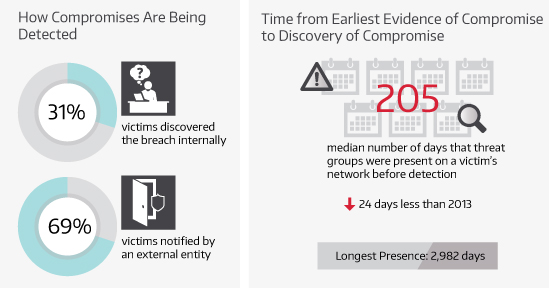
In an era where everyone is used to, and in fact demands, instant gratification, and where we have a one hundred billion dollar plus cyber security industry providing the tools and solutions to satisfy that demand, MTTD is still 6+ months. We cannot underestimate the ability of criminals to stay ahead of conventional solutions by constantly adapting – allowing them to hide their malicious intentions or simply fly under the radar. These low and slow attacks have become the Achilles heel of organizations worldwide. The data breaches that will be announced next year are taking place right now, as you’re reading this article. The attackers are already in the networks and systems doing their reconnaissance work, exfiltrating data, planning their next move – all the while, blending into the noise of everyday business users and operations for months and years at a time. How can one detect these anomalies?
Data is King
We use data every day to gain insight, plan our next moves and run our organizations. Too little data and you’re not getting the complete picture to make an informed decision, too much data and you’re overwhelming your staff and drowning in the noise to make any sense out of it. Analyzing the vast amounts of data to detect pattern anomalies requires specialized knowledge and takes time. Attackers know this.
Traditional SIEMs and log management devices do what they do well. They aggregate data from multiple sources, report on the verticals you tell them to report on, and allow your auditor to put a tick in the PCI-DSS compliance checkbox for requirement 10.5.3. You would think that should make your CISO sleep better at night, but ticking the compliance box is all that exercise will allow you to do, and I guarantee you your CISO is not sleeping any better at night.
We are bombarded by marketing buzz words like “Big Data” and “Data Lakes”; how can we strip away the marketing buzz and introduce the concepts into our security strategy and use them to our advantage?
Hello Security Intelligence!
Security Intelligence and Analytics is the concept of collecting, normalizing and correlating the data you already have access to from the myriad systems and solutions that have been deployed in the enterprise. Typically a time consuming exercise for highly skilled data scientists, applying computer based algorithms and data analytics to the vast amount of data in order to detect valid security events introduces a new dimension to data intelligence that can be used for tracking security incidents before they occur, ultimately reducing the Mean Time to Detection, and potentially saving organizations millions of dollars and often more importantly - from appearing on the front pages.
Security Intelligence algorithms and analysis techniques take the data sets that are already being generated from disparate sources in your enterprise, such as security audits, application logs, network flows, vulnerability management, configuration data, keystroke logs etc… It slices and dices that data, pivots the data and ultimately correlates the common elements between these unrelated sources while adding a layer of context to the correlation based on specific indicators of compromise for that system. You have now armed yourself with a proactive method to track anomalies and detect security events important to your environment, while separating the noise from the actionable data.
This real time correlation and contextualization of data sources enables notifications to security analysts of the anomalies that are being measured on a system as they’re occurring. Say for example commands are being issued on a system that are not typical of the user issuing them. By recognizing this and correlating that activity with suspicious network flow and additional sources of data, security intelligence algorithms can detect and alert that something is happening on the system that is outside of what is normal for the given environment. This powerful concept provides meaningful comprehension of the data, allowing security practitioners to have the upper hand in detecting suspicious activity before you’ve reached the tipping point..
Highest ROI in the Enterprise
Sorting through millions of events to find something that is important to you is a near futile effort. It’s like searching for the proverbial needle in a haystack, meanwhile, more hay is being shoveled onto the stack at an alarming rate. This taxes resources, sends people and applications down rabbit holes chasing false positives, compromises system availability and ultimately wastes time and money, not to mention everything else involved with a large breach. This is why it’s 2015 and the MTTD is still 200+ days.
Figure 2.
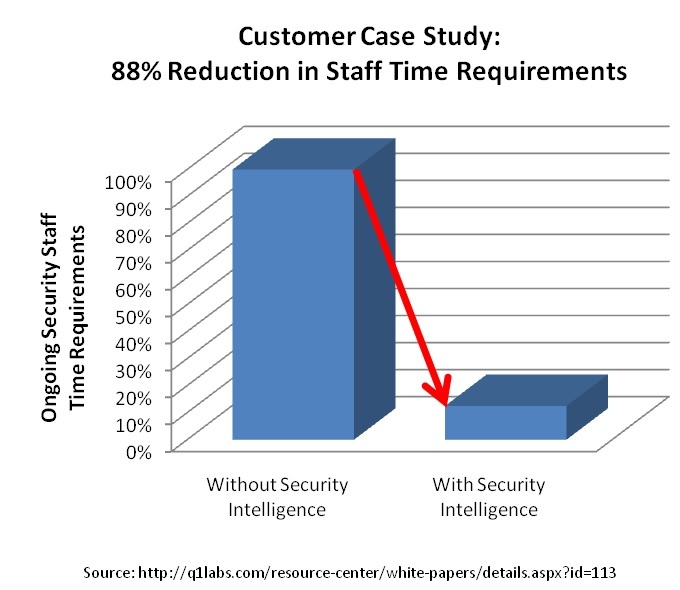
The value of security intelligence and the way it takes the human effort involved in data analysis, contextualization, correlation and pattern matching and automates it cannot be underestimated.,. This complex analysis allows for efficient and effective processing of security data, so your security team can make quicker, informed decisions on events that are relevant to them. This in turn yields additional benefits by reducing operational costs, simplifies management, enhances security and increases response times. This is why Security Intelligence and Analytics have one of the highest perceived ROIs compared to its cost.
Organizations recognize the value of intelligence based on data analysis in other parts of their business strategy, like marketing – security intelligence is no different. Being able to leverage the data you already have access to through automated analysis empowers your organization to quickly and efficiently deal with the threats that are constantly evolving.
¹ Source: MANDIANT M-Trends 2015: A VIEW FROM THE FRONT LINES
Steve
Tcherchian, CISSP
CISO
XYPRO Technology
Steve Tcherchian is the CISO for XYPRO Technology. With almost 20 years in the cybersecurity field, Steve is responsible for overseeing XYPRO’s risk, compliance, infrastructure and product security to ensure the best security experience to customers in the Mission-Critical computing marketplace.
XYPRO – HP NonStop Advanced Technical Boot Camp

Please join XYPRO at the HP NonStop Advanced Technical Boot Camp thisNovember 15–18, 2015 in San Jose, California. This event is designed specifically for HP NonStop professionals and anyone interested in learning more about XYPRO's extensive line of Compliance, Access Control, Audit, Authorization, Encryption, Tokenization and Professional Service offerings.
This year, XYPRO is launching a brand new product sure to be the “Next Big Thing in HP NonStop Security”. It’s a can’t miss presentation – you’ll definitely want to be in the audience for this one!
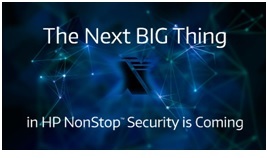
As a proud Diamond sponsor we’ve created a special landing page to keep you updated on all the XYPRO, HP & User Presentations!

|
Find out more about us at
www.tandemworld.net
+44 (0) 20 8304 7979
We would like to thank the sponsors of the October 2015 eNewsletter
Gold Sponsor
Silver Sponsor
To enquire about Sponsorship opportunities for the Tandemworld Newsletter please click here.
Current Subscribers 15142
Our company, Tandemworld, accepts no
liability for the content of this email, or for the consequences of any
actions taken on the basis of the information provided.
To Unsubscribe or Change your Subscription Please click here

